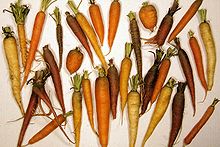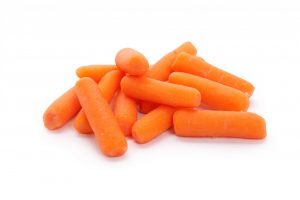One of the easiest to like vegetables is the carrot. It’s high in sugar, so it’s sweeter than lots of other vegetables. Many people like to eat carrots raw. If you’re cooking them, there are lots of options.
Carrots as we know them are bright orange roots with feathery green tops that are a hybrid. The earliest carrots probably came from around Afghanistan. They are related to parsley, fennel, dill, and cumin. There are many varieties, much redder than orange, some almost black.
Young carrots can last for up to a week, but older, larger versions without the tops can last up to four weeks in a cool environment. These are one of the very few vegetables that can actually be enhanced by cooking for their nutrient value. Cooking helps the body better absorb beta-carotene. This nutrient turns into Vitamin A which is important to eye health.
Better quality carrots will still have the greens attached. These are usually smaller and have a sweeter taste and a less woody texture. Select carrots that are free from blemishes or spots and which don’t have any sort of film on the skin.
Many people recommend peeling the carrots, giving you a more tender product. But many nutritionists say the skin should stay on, just very strongly scrubbed. Older, larger carrots probably should be peeled because they tend to dry out. Younger, smaller carrots have less thick skins.
Remove the greens before cooking. But don’t throw them away. They can be used as herbs or to add flavor to a stock. Trim off the top where the green was attached and the tap root end.
Boiling, steaming, microwaving, or sautéing are probably the most common ways to prepare them. In each case, they should be cut into 1/8th inch thick rounds and should be done in about four minutes in high heat. Sautéing with some butter is very popular. They can be glazed easily just by adding a teaspoon of sugar, syrup, or honey at the end. Most of the time, all they really need is a tiny bit of salt and pepper. In the microwave, put into a glass dish with about 1/4 cup of water or white wine, cover tightly, and heat on high for about three minutes.
Stir-frying is also popular. Cutting the carrots in half and then into two-inch long sections will allow you to cut them into sticks, or juliennes, which cook quickly and evenly. Carrots should be added early in the stir-frying with any other hard vegetables.
To roast, preheat the oven to 450 or 500. Cut the carrots in half and then into short (about 1-1/2 inches) lengths. Coat with about two teaspoons of extra virgin olive oil and spread evenly on a cookie or baking sheet. Bake for about 15 minutes, turning once about halfway through.
Regardless of the variety, they pretty much taste the same. So, don’t be afraid of heirloom carrots in the store or farmers’ market, even if they look a little strange.




